

Five Platforms for a Classroom Back-channel Chat. Over the last month since I shared my positive experiences (here and here) of using a back-channel chat in my classroom, I've received quite a few questions about services that can be used for hosting back-channel discussions.
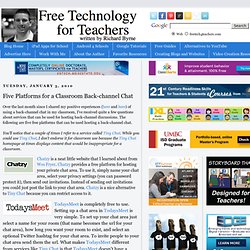
The following are five free platforms that can be used hosting a back-channel chat. You'll notice that a couple of times I refer to a service called Tiny Chat. While you could use Tiny Chat, I don't endorse it for classroom use because the Tiny Chat homepage at times displays content that would be inappropriate for a classroom. Chatzy is a neat little website that I learned about from Wes Fryer. Chatzy provides a free platform for hosting your private chat area. TodaysMeet. TweetBeam Twitter Wall - Visualize Live Tweets.
Social Networks For Teachers On The Rise As Popular Social Media Raise Concerns. Within the wide expanse of social networking, educators appear to be gravitating to more protected and exclusive spaces.
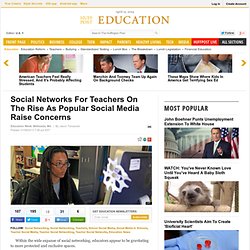
While teachers often use such popular mainstream social networks as Facebook, they are more likely to seek out and return to less-established networks that offer the privacy, peer-to-peer connections, and resource sharing that meets their specific professional needs, according to a recent survey and interviews with educators. "A lot of teachers are on Facebook as general-population consumers," said Jessie Arora, the founder of Teacher Square, an organization that helps teachers share information around educational technology. "[But] they aren't on Facebook with their teacher hats on. " Educators' use of popular networks like Facebook and Twitter has increased overall, but those sites are often blocked in schools and fraught with ethical concerns because so many students use them. But the survey revealed interesting data on less common social-network use among educators.
How teachers use social media in the classroom to beef up instruction. While plenty of their parents might see using social media sites like Twitter, Facebook and blogs as a leisure time activity, students today know better: These days, those web portals can be some of the best places to find information on the subjects they’re covering in school.
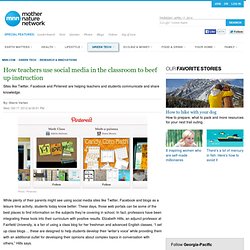
In fact, professors have been integrating these tools into their curriculum with positive results. Elizabeth Hilts, an adjunct professor at Fairfield University, is a fan of using a class blog for her freshman and advanced English classes. “I set up class blogs ... these are designed to help students develop their 'writer’s voice' while providing them with an additional outlet for developing their opinions about complex topics in conversation with others,” Hilts says.
Dr. Even Pinterest, the photo-sharing creative site, can be a boon for teachers. “Social networking has all the same risks as the traditional online safety risks. In and Out of the Classroom: Using Social Media in Ways that Matter. Because so many students use social media tools – and because so many faculty use the same tools in their personal or professional lives – it can be tempting to bring social media into the classroom almost by default, on the assumption either that social media technologies are needed to engage students or that they will boost student engagement simply by their use.
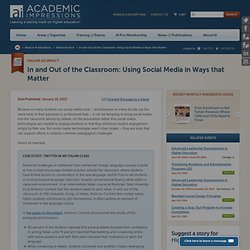
But social media technologies aren’t silver bullets – they are tools that can support efforts to address common pedagogical challenges. Here’s an example. Perennial challenges in traditional (non-immersive) foreign language courses include a) how to best encourage student practice outside the classroom, where students have limited access to conversation in the new language, and b) how to aid students in moving beyond language “exercises” toward conversational fluency while within a classroom environment. In her paper on the subject, Antenos-Conforti documented the results of this pedagogical innovation: Using social media to enhance learning outside the classroom. Beyond Facebook: 5 Tips to Using Social Media in the Classroom. Guest column by Erik Deutsch It’s not enough for instructors to just talk about social media; they need to make it part of the curriculum.
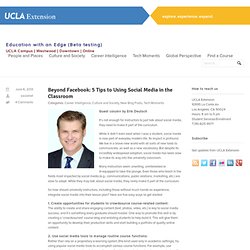
While it didn’t even exist when I was a student, social media is now part of everyday modern life. Its impact is profound. We live in a brave new world with all sorts of new tools to communicate, as well as a new vocabulary. But despite its incredibly widespread adoption, social media has been slow to make its way into the university classroom. Many instructors seem unwilling, uninterested or ill-equipped to take the plunge.
So how should university instructors, including those without much hands-on experience, integrate social media into their lesson plan? 1. 2. 3. 4. 5. Erik Deutsch teaches public relations and social media best practices at UCLA Extension. Like this: Like Loading... 7 Tips For Using Social Media in Your Classroom. 4 Ways To Improve School Communication Using Social Media. In the past three decades, the presence of technology in the school and classroom has gone from practically nonexistent to being a vital part of the learning experience. As computers and other forms of technology filtered into the classroom, the ability to improve school communication via computer also impacted the way school districts kept parents and staff members informed.
The rapid growth of social media offers communication opportunities that are not found so easily by visiting a school district website. Many of these websites, though they’re well-intended, require the visitor to click through several screens to get to the information they desire. As technology progresses, people are less willing to go through this process when more efficient methods of communication exist. Students Speak Up in Class, Silently, via Social Media.